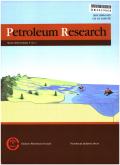Electrofacies-driven 3D-static reservoir modeling of the Late Cenomanian AbuRoash’G Member (Abu-Gharadig Basin, Egypt): Sequence stratigraphic and geomodel constraints for a gas-bearing estuarine system
IF 4
Q1 Earth and Planetary Sciences
引用次数: 0
Abstract
Estuarine-systems, developed upon transgressive-phases, feature high-quality reservoir-facies, e.g. tidal-bars, that are important stratigraphic-plays critical for hydrocarbon exploration-development. However, capturing their intricate architectural elements (heterogeneity and quality) is still challenging due to the complex stacking-nature and limited-examples. Moreover, defining reservoir-boundaries upon static-modeling of reservoirs cannot be efficient unless it is controlled by stratal-geometries and established depositional-models. To this end, in this study, we performed 3D-static geocellular reservoir-modeling process for the Late-Cenomanian AbuRoash“G” Member (Abu-Gharadig Basin, Egypt) with sequence-stratigraphic and geomodel, relative-geological-time (RGT) model and horizon-stacks, constraints. In this investigation, as an effective-workflow, not only facies-analysis, integrating seismic-stratigraphy and GR-log motifs, was applied for paleo-environment reconstruction, but also machine learning-based electrofacies were applied, through self-organized-maps (SOM), to accurately recognize complex facies-assemblages present. Object-based and pixel-based stochastic-simulation processes were applied upon geocellularly modeling rock and fluid properties, utilizing key-information scales of seismic and well-log data. The results show that three third-order depositional sequences dominate the succession, resting on the Late-Cretaceous unconformity, of which sequence-1 encloses the lowstand and transgressive systems-tracts of the fluvio-estuarine Bahariya and Abu Roash“G” units, respectively. The transgressive phase built AbuRoash“G” lithounit features an estuarine depositional-system encompassing four facies-associations, of which tidal-sand-bars represent significant gas-bearing reservoir-quality facies. The tidal-bar facies’ efficient reservoir quality calls for attention and testing in future development plans and investigation in similar settings. Furthermore, the facies-constrained workflow established in this study, for reservoir modeling, can effectively help identify the ultimate reservoir-configuration worldwide, as long as the 3D-static modeling process is controlled by the stratal and geomodel restraints.
晚更新世 AbuRoash'G lithounit(埃及 Abu-Gharadig 盆地)电成因驱动的三维静态储层建模:含气河口系统的层序地层学和地质模型制约因素
在海侵相基础上发育的河口体系具有高质量的储层相,如潮坝,是油气勘探开发的重要地层油气藏。然而,由于复杂的堆栈性质和有限的示例,捕获它们复杂的体系结构元素(异构性和质量)仍然具有挑战性。此外,除非受到地层几何形状和已建立的沉积模型的控制,否则根据储层静态建模来确定储层边界是不可能有效的。为此,在本研究中,我们利用层序地层和地质模型、相对地质时间(RGT)模型以及层位叠层约束条件,对埃及Abu-Gharadig盆地晚cenomanian AbuRoash“G”段进行了三维静态地质体储层建模。在本研究中,作为一种有效的工作流程,不仅应用相分析,结合地震地层学和GR-log主题进行古环境重建,还应用基于机器学习的电相,通过自组织图(SOM)准确识别存在的复杂相组合。利用地震和测井数据的关键信息尺度,将基于对象和基于像素的随机模拟过程应用于岩石和流体性质的地球细胞模拟。结果表明,以晚白垩世不整合为基础的3个三级沉积层序主导了该序列,其中层序1分别包裹了河河口Bahariya和Abu Roash“G”单元的低水位和海侵体系域。AbuRoash“G”岩单元的海侵期为河口沉积体系,包括4个相组合,其中潮砂坝是重要的含气储集相。潮坝相高效的储层质量值得在今后的开发规划和类似环境的调查中予以重视和检验。此外,只要三维静态建模过程受地层和地质模型约束,本研究建立的储层建模相约束工作流可以有效地帮助识别全球范围内的最终储层构型。
本文章由计算机程序翻译,如有差异,请以英文原文为准。
求助全文
约1分钟内获得全文
求助全文
来源期刊

Petroleum Research
Earth and Planetary Sciences-Geology
CiteScore
7.10
自引率
0.00%
发文量
90
审稿时长
35 weeks
 求助内容:
求助内容: 应助结果提醒方式:
应助结果提醒方式:


